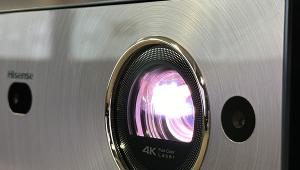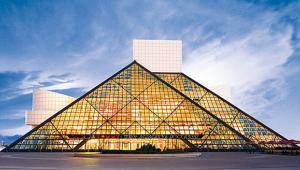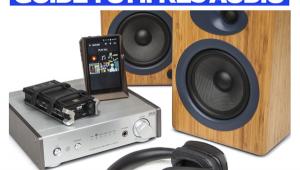4K Projector Buyer’s Guide Home Theater Projectors
Best 4K Dedicated Home Theater Projectors
JVC DLA-NZ7($9,000)
JVC is the go-to brand for home theater enthusiasts willing to put in the legwork to get the most cinematic result. And its DLA-NZ7 is an 8K e-shift (pixel-shift) model with native 4K three-chip D-ILA as the foundation. JVC has the secret sauce when it comes to HDR tone mapping. I've seen this projector doing its thing and it is the single best projector in this roundup for use in home theaters. How do I know? I've directly compared it to the Epson LS12000 and Sony XW5000ES and seen it pull ahead in every appreciable sense. Which, given the asking price, is what you'd hope it does. Clearly sharper, with more contrast and better HDR handling.
I know numerous picky home theater enthusiasts that have settled on this projector after considering all options. It is practically iconic.
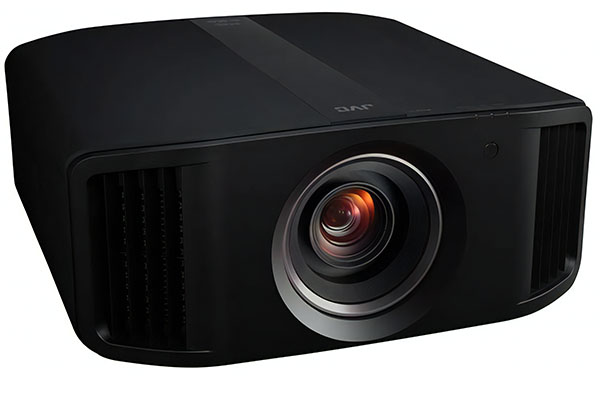
JVC's DLA-NZ7, a favorite among home theater enthusiasts, stands out with its 8K e-shift technology built on a native 4K three-chip D-ILA system. Known for its exceptional HDR tone mapping, this projector delivers a top-notch cinematic experience. It combines 8K e-shift with Frame Adapt HDR Generation 2 for dynamic HDR10 content, and its 17-element all-glass lens ensures sharp 8K images. The projector's dynamic contrast ratio reaches infinity:1, and native contrast is 40,000:1, backed by a 0.69-inch 4K D-ILA device and dynamic light source control. Its BLU-Escent Laser Diode light source offers high brightness and a 20,000-hour lifespan.
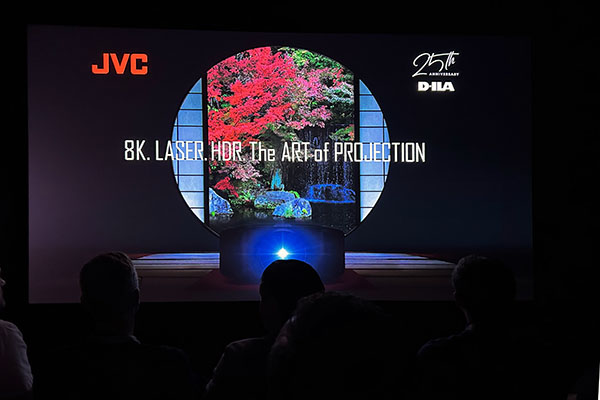
The D-ILA technology largely responsible for JVC's picture quality had its 25th anniversary last year.
The DLA-NZ7 supports HDR10, HDR10+, and HLG formats and features a 4K120p input with Low Latency Mode, suitable for gaming. It includes Filmmaker Mode™ for authentic movie experiences and various installation options. With 2200 lumens brightness, 12-bit color depth, and a 2x zoom lens, it provides versatile, high-quality projection. Additionally, it is 3D-capable and has HDMI ports that support up to 8K60P input. If you love movies and can afford one, this is the machine for you.
- 8K e-shift Technology: Built on a native 4K three-chip D-ILA system, providing sharp 8K images.
- Exceptional HDR Tone Mapping: Integrates Frame Adapt HDR Generation 2 for dynamic HDR10 content, enhancing the cinematic experience.
- High-Quality Lens and Contrast Ratios: Features a 17-element all-glass lens, infinity:1 dynamic contrast ratio, and 40,000:1 native contrast.
- Advanced Light Source and Device: Utilizes a BLU-Escent Laser Diode light source with a 20,000-hour lifespan and a 0.69-inch 4K D-ILA device.
- Comprehensive Format and Input Support: Supports HDR10, HDR10+, HLG formats, and 4K120p input with Low Latency Mode for gaming, along with 3D capability and HDMI ports for up to 8K60P input.
Sony VPL-XW5000ES ($5,000)
Sony's VPL-XW5000ES is a native 4K home theater projector with a laser-phosphor light source. If you go searching you'll find it is the least expensive projector that can make this boast. I reviewed this projector not so long ago and found it a worthy successor to the VPL-VW325ES, even if in order to maintain its price point it sacrifices ergonomics for performance.
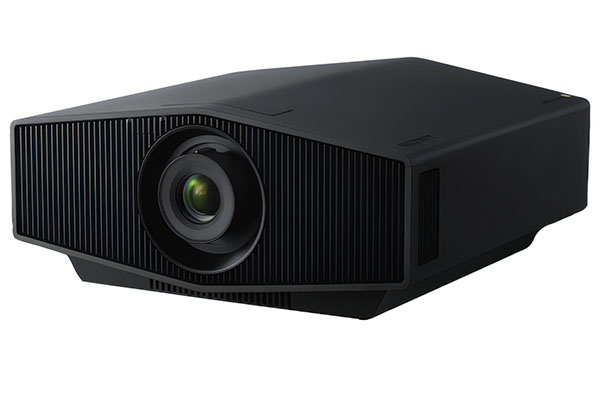
The Sony stands out for its affordability and advanced features, including a laser-phosphor light source and a new 4K SXRD panel. Priced at $4,999, it offers a cost-effective solution for high-resolution projection needs. Its 20,000-hour laser light source ensures durability and fast operation. However, the projector's manual lens, smaller and with a shorter zoom than its predecessor, may restrict its use in some spaces and, despite careful adjustment, may not achieve perfect sharpness.
The Sony VPL-XW5000ES projector, lacking HDR10+ compatibility, uses HDR tone-mapping when aiming to accurately represent the creator's vision, although this is an area where JVC has an advantage. The projector is relatively appealing for gamers, offering a low input lag of 21 ms (or less) at 4K/60p.
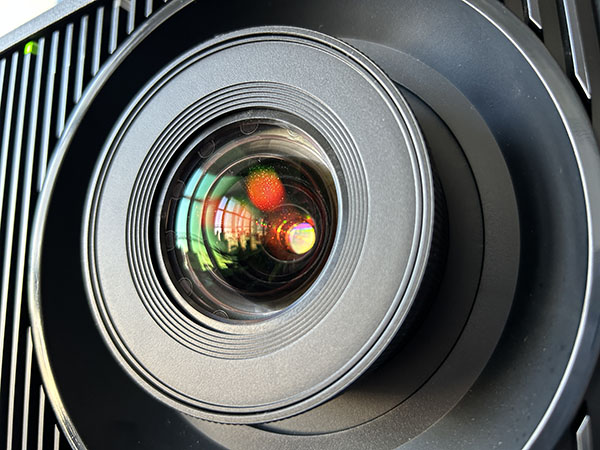
The XW5000ES lens.
For connections, it includes two HDMI inputs, an RJ45 LAN port, RS232C, IR input, and a 12-volt trigger. However, its lack of an RF 3D emitter output means it doesn't support 3D playback, which could disappoint enthusiasts of 3D content.
What I have seen time and again from this particular projector is that it offers the bulk of the quality and capability of its pricier siblings at a fraction of the cost, so long as you can live with the indignity of manual lens adjustment.
- Affordable Native 4K Projection: Priced at $4,999, offering a cost-effective solution for high-resolution, native 4K projection.
- Laser-Phosphor Light Source: Equipped with a 20,000-hour laser light source for long-lasting, fast operation.
- New 4K SXRD Panel: Features an advanced 4K SXRD panel with native 2160x3840 pixel resolution.
- Low Input Lag for Gaming: Offers a low input lag of 21 ms (or less) at 4K/60p, making it appealing for gamers.
- Versatile Connectivity Options: Includes two HDMI inputs, RJ45 LAN port, RS232C, IR input, and a 12-volt trigger, but lacks 3D capabilities.
Epson LS12000 ($5,000)
The Epson LS12000 is a pixel-shift 4K projector that sacrifices a bit of raw contrast performance—primarily black levels—relative to JVC and Sony but makes up for it with features. Most notably you get a sophisticated lens with power focus, zoom and shift, along with lens memory slots for different configurations. Long story short, this is a projector that you can program to work with a variable aspect ratio screen.
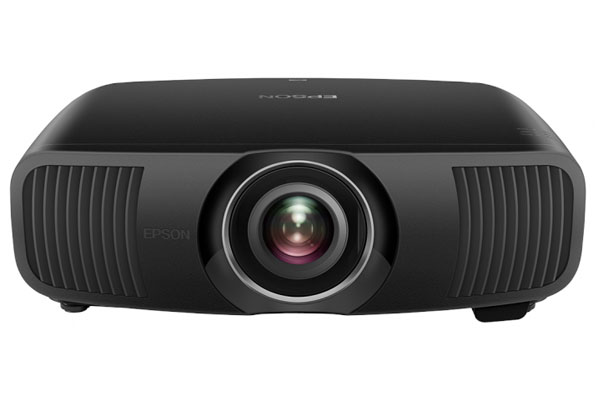
The LS12000 features advanced pixel shift technology to deliver 4K resolution (3840x2160) from three 1080p LCD chips. It offers up to 2,700 ANSI lumens of brightness from a solid-state laser light source, HDR10+ support, and less than 20 ms input lag for gaming. However, it lacks 3D capabilities and dynamic tone-mapping for HDR10.
Epson's new blue laser diode array creates an efficient white light source with low heat and consequently minimal fan noise. This light converts to the three primary colors for the projector's LCD panels, ensuring equal brightness and eliminating rainbow effect. The laser's lifespan reaches up to 20,000 hours.
The LS12000 uses the Epson VRX Cinema Lens, a 15-element structure for zero light leakage and uniform focus. Its 2.1x zoom and broad throw ratio range allow versatile placement, complemented by powered focus, zoom, and lens shift for easy setup. The projector dynamically adjusts contrast using a Dynamic Contrast laser dimming function but lacks an auto iris.
For HDR content, it features a 16-point HDR Dynamic Range slider and Scene Adaptive Gamma, using the ZX processor for frame-by-frame enhancements. However, the absence of dynamic tone mapping may limit its performance. The LS12000 has two HDMI 2.1 inputs, supports 4K at 120 Hz, and offers calibration options, though it may slightly crush bright whites with HDR.
- Advanced Pixel Shift 4K Technology: Delivers 4K resolution (3840x2160) using three 1080p LCD chips, providing high-quality image resolution.
- Solid-State Laser Light Source: Features up to 2,700 ANSI lumens of brightness and a new blue laser diode array, offering efficient white light with low heat and minimal fan noise.
- Epson VRX Cinema Lens: Utilizes a 15-element lens structure for zero light leakage and uniform focus, with powered focus, zoom, and lens shift for easy setup.
- Dynamic Contrast and HDR Support: Includes a Dynamic Contrast laser dimming function and a 16-point HDR Dynamic Range slider, although it lacks dynamic tone mapping for HDR10.
- Connectivity and Gaming Support: Offers two HDMI 2.1 inputs, supports 4K at 120 Hz, and provides less than 20 ms input lag for gaming, but lacks 3D capabilities.

